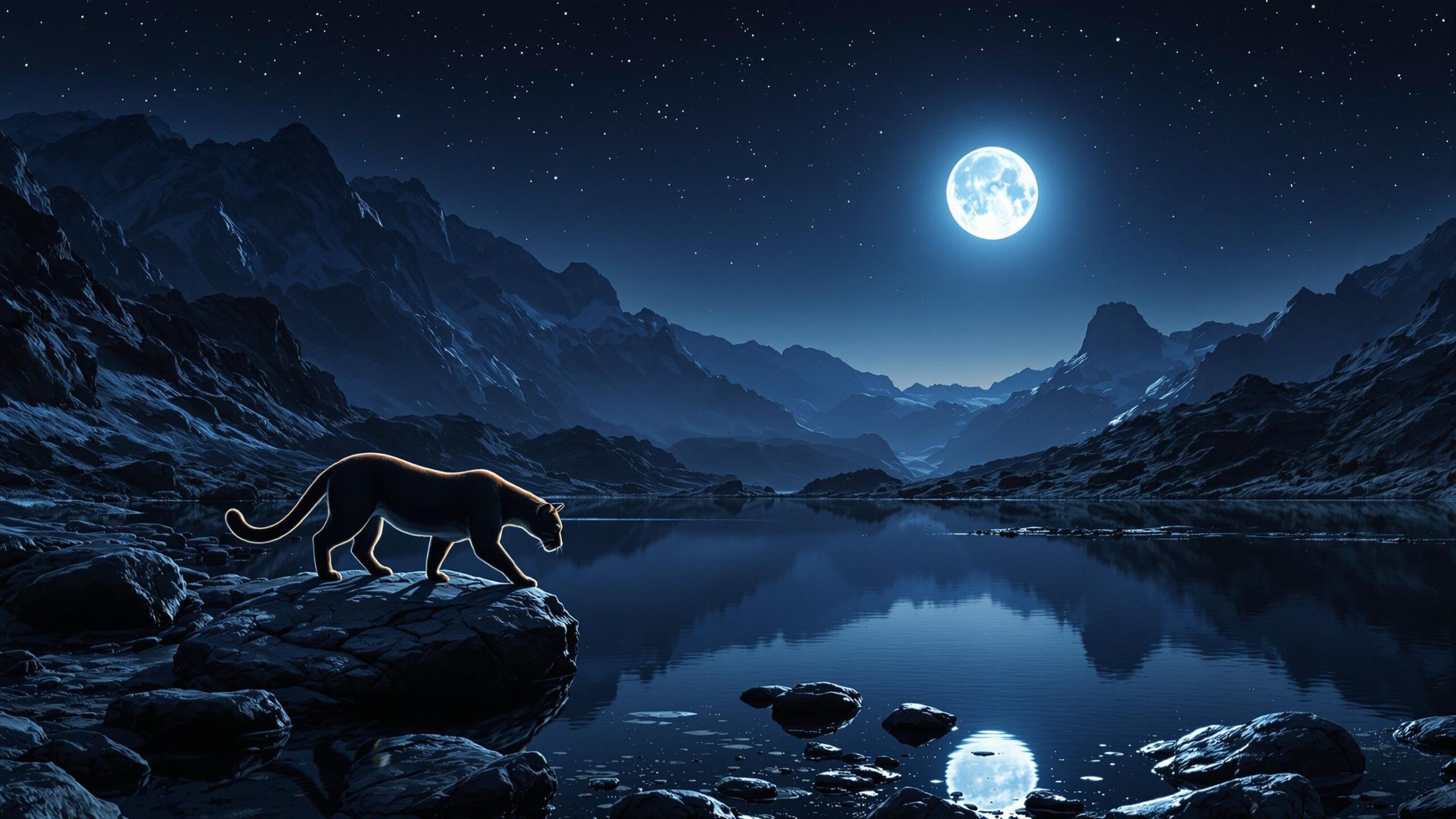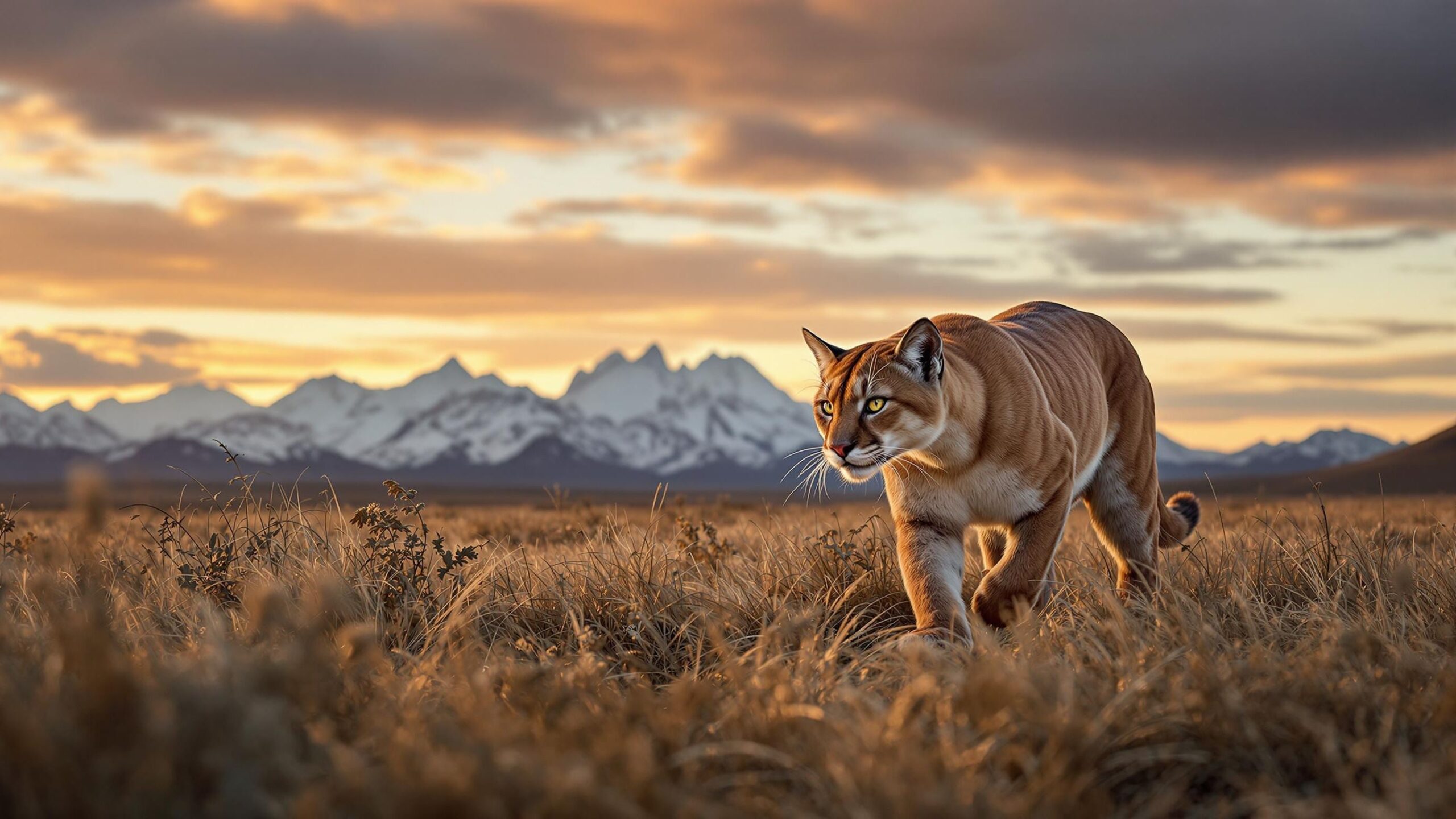The South American Puma: Ghost of the Andes and Guardian of the Wild
Graceful, elusive, and commanding, the South American puma is a creature that has roamed the rugged and varied landscapes of the continent for millennia. Known scientifically as Puma concolor concolor, this large cat is one of the most widespread carnivores in South America. From the windswept plains of Patagonia to the dense Amazon rainforest and the towering peaks of the Andes, the South American puma has adapted to survive in some of Earth’s most challenging habitats.
Though sometimes overshadowed by the jaguar, the puma possesses a mystique all its own. It is a solitary shadow, a whisper in the mountains, and a key figure in both the ecological web and the spiritual imagination of South America. This is a predator that has managed to endure through ages of change—natural and human alike—without losing its wild dignity.
A Cat of Many Landscapes
The South American puma boasts the largest range of any terrestrial mammal in the Western Hemisphere, stretching from northern Colombia and Venezuela to the southernmost tip of Chile and Argentina. Unlike its North American cousin, which tends to avoid tropical environments, Puma concolor concolor thrives in a much broader array of ecosystems. It is equally at home stalking guanacos on the windswept Patagonian steppe, ambushing capybaras in Amazonian wetlands, or slipping between the rocky crags of the Andes.
This remarkable versatility is due to both physical and behavioral adaptations. The South American puma is highly agile, with powerful limbs, sharp reflexes, and a flexible spine that allows it to leap great distances. Its thick, muscular tail provides balance during high-speed chases and sharp turns, while its uniformly tawny coat blends seamlessly into a variety of backdrops, offering natural camouflage in grasslands, forests, deserts, and snow-capped peaks alike.
As a generalist predator, the South American puma has learned to hunt whatever prey is available. In Patagonia, it feeds primarily on guanacos and hares. In the Amazon, it may target monkeys, birds, and large rodents. In the Andean foothills, its diet includes deer, foxes, and domestic livestock. This dietary flexibility has helped the puma maintain its territory even as human activities reshape the landscape.
Origins and Evolution
The evolutionary roots of the puma trace back to North America during the Pliocene epoch, about three million years ago. Its ancestors crossed the Isthmus of Panama during the Great American Biotic Interchange, spreading into South America and giving rise to the subspecies we know today as Puma concolor concolor. Over time, isolated populations developed traits suited to their unique environments, though all remain part of the same adaptable species.
Unlike the jaguar, its fellow big cat in the region, the puma is not a member of the Panthera genus and therefore cannot roar. Instead, it communicates through a range of vocalizations that include hisses, growls, chirps, and eerie screams that can echo across valleys like a banshee’s wail. These sounds, along with scent markings and visual cues, help pumas establish territory and communicate during mating season.
Solitary and Elusive
The South American puma is an elusive and solitary animal by nature. Except for females raising cubs or during brief mating encounters, pumas live and hunt alone. Each individual requires a large home range to meet its dietary needs, and the size of that range varies depending on prey availability and habitat quality. In open grasslands with sparse prey, a male’s territory can stretch hundreds of square kilometers. In prey-rich forests, territories may be smaller.
Pumas are primarily crepuscular, meaning they are most active at dawn and dusk. Their vision and hearing are finely tuned for low-light conditions, allowing them to silently stalk prey through underbrush or across open terrain. A typical hunt involves stalking within close range, followed by a powerful ambush. They usually kill with a suffocating bite to the throat or a crushing blow to the skull. Once a kill is made, a puma may drag its prey to a secluded area, covering the carcass with leaves or dirt to conceal it from scavengers. The cat may return to the kill site for several days, feeding gradually and moving cautiously. This stealthy behavior helps reduce risk of confrontation with larger predators like jaguars, bears, or even humans.

Birth and Growth
Breeding in South American pumas is not strictly seasonal and can occur throughout the year. After mating, the female undergoes a gestation period of approximately 90 to 96 days before giving birth to a litter of one to six cubs. The cubs are born in a hidden den, blind and vulnerable, with spotted coats and blue eyes.
These spots, reminiscent of their distant evolutionary ties to other big cats, provide camouflage during the early months. As they grow older, their coat becomes solid and their eyes change to a yellowish-gold. Cubs remain with their mother for up to two years, during which they learn critical survival skills such as hunting, navigating terrain, and avoiding danger. Once they mature, juvenile pumas leave to establish their own territories. These dispersal journeys are risky, often taking the young cats across dangerous landscapes fragmented by roads, settlements, and farmland. Many do not survive the transition to adulthood, but those who do carry the genetic legacy of resilience into new corners of the continent.
Ecological Importance
Despite its elusive nature, the South American puma is a keystone species. Its role in regulating prey populations has wide-ranging ecological impacts. By keeping herbivore numbers in check, pumas help maintain healthy vegetation and prevent overgrazing. This, in turn, supports broader biodiversity by preserving habitats for smaller mammals, birds, and plant communities.
In regions like Patagonia, where large predators such as wolves and bears are absent, the puma is the dominant carnivore. Its influence extends not only to prey but also to scavenger communities that rely on leftovers from puma kills. And where pumas are present, prey species alter their behavior—avoiding certain areas or becoming more vigilant—which further shapes the structure of the ecosystem. These complex relationships illustrate how apex predators like the puma are not just hunters, but architects of their environments. Their disappearance would trigger cascading effects throughout the food web, leading to imbalances that affect both wildlife and human livelihoods.
The Human Factor
Throughout history, the puma has held a symbolic place in the cultures of South America. In Andean mythology, it was often seen as a powerful and sacred animal. The Inca believed the puma represented strength and was one of the three sacred animals in their cosmology, alongside the condor and the serpent. Images of pumas appear in ancient stonework, pottery, and oral tradition as protectors of balance and harmony.
Despite its revered status in some indigenous belief systems, the puma has long been viewed as a threat by ranchers and rural communities. Livestock depredation, whether real or perceived, often leads to retaliation. Pumas are sometimes hunted, poisoned, or trapped in response to livestock losses, even though such conflicts are often preventable with proper livestock management techniques. Modern conservation efforts aim to reduce these conflicts through education, non-lethal deterrents, and economic incentives for coexistence. In some areas, community-based programs have successfully demonstrated that carnivores and people can share landscapes if mutual respect and understanding are fostered.
Conservation Outlook
The South American puma is currently listed as Least Concern by the IUCN, primarily due to its wide distribution and relatively stable population in several regions. However, this classification masks localized threats and regional declines, particularly in areas where habitat loss and human conflict are severe. The puma’s future is closely tied to the preservation of large, connected wildlands. In countries like Chile and Argentina, protected areas such as Torres del Paine, Los Glaciares, and Parque Patagonia provide crucial refuges for thriving populations. In Brazil and Peru, pumas inhabit remote tracts of rainforest, where they share territory with jaguars and ocelots in a delicate balance of competition.
Nonetheless, the puma faces mounting pressure from deforestation, mining, agriculture, and infrastructure expansion. Roads fragment habitat, making it harder for pumas to move, hunt, and find mates. Illegal hunting remains a concern, particularly in regions with limited enforcement or conservation awareness. Collaborative projects that connect protected areas, promote wildlife corridors, and involve local communities in stewardship are showing promise. By aligning conservation goals with sustainable development, South American countries are finding ways to protect the puma while supporting rural economies.

A Cultural and Ecotourism Icon
In recent years, the South American puma has emerged as an icon of ecotourism, particularly in Patagonia. Wildlife photographers, hikers, and conservationists flock to places like Torres del Paine in hopes of glimpsing these elusive cats in their natural habitat. As one of the few places in the world where pumas can be seen in the wild with relative reliability, these regions are proving that large predators can be more valuable alive than hunted.
The growth of ethical ecotourism is helping to shift perceptions. Where pumas were once feared and persecuted, they are now becoming sources of pride and economic opportunity. Local guides, many of whom once viewed pumas as a threat to livestock, are now leading tours and sharing their knowledge with visitors from around the globe. This change in attitude reflects a broader shift in how we value nature—not just as a resource to be used, but as a living heritage to be respected and preserved. The puma’s ability to stir awe and curiosity makes it a powerful ambassador for conservation.
The Puma’s Path Forward
As one of the most adaptable large carnivores in the world, the South American puma is well-equipped to survive—if given the space and freedom to do so. Its resilience in the face of changing environments and human expansion is an example of evolutionary genius. But resilience has its limits.
Protecting the puma means protecting the landscapes it needs to roam, hunt, and raise its young. It means investing in science, policy, and people. It means seeing the puma not as a symbol of danger, but as a fellow inhabitant of this diverse and vibrant continent. Ultimately, the story of the South American puma is a story of balance—between predator and prey, between nature and development, between fear and understanding. As South America moves into the future, the puma walks ahead as both a guardian of the past and a guide to what’s still wild.
More Articles

Global Leaders Meet to Address Climate Change Crisis
Orci nec curabitur ad hendrerit inceptos nunc sollicitudin sagittis odio, dignissim montes fermentum neque purus nostra nibh pellentesque, curae potenti maecenas eget ligula sem at ullamcorper. Laoreet tempus euismod auctor cubilia dapibus duis enim at, cum quis cras fermentum nulla malesuada orci torquent proin, cursus eros pulvinar volutpat urna tortor varius.

Apple Unveils New iPhone with Revolutionary Features
Orci nec curabitur ad hendrerit inceptos nunc sollicitudin sagittis odio, dignissim montes fermentum neque purus nostra nibh pellentesque, curae potenti maecenas eget ligula sem at ullamcorper. Laoreet tempus euismod auctor cubilia dapibus duis enim at, cum quis cras fermentum nulla malesuada orci torquent proin, cursus eros pulvinar volutpat urna tortor varius.

Stock Market Reaches All-Time High Amid Economic Recovery
Congue donec potenti enim himenaeos morbi tempor libero torquent pretium nunc interdum, lacus ullamcorper tristique natoque sagittis molestie aliquet sociis condimentum feugiat, nisl malesuada ante cubilia montes eu diam nostra fermentum platea. Suspendisse sed ut placerat luctus sociis donec lobortis enim nisi netus duis, cubilia sem mus posuere purus malesuada feugiat dictum morbi ornare, nam augue tempus facilisis natoque quis pretium torquent fermentum praesent. Molestie etiam magna nam maecenas augue

Olympic Games 2024: Highlights and Medal Count
Congue donec potenti enim himenaeos morbi tempor libero torquent pretium nunc interdum, lacus ullamcorper tristique natoque sagittis molestie aliquet sociis condimentum feugiat, nisl malesuada ante cubilia montes eu diam nostra fermentum platea. Suspendisse sed ut placerat luctus sociis donec lobortis enim nisi netus duis, cubilia sem mus posuere purus malesuada feugiat dictum morbi ornare, nam augue tempus facilisis natoque quis pretium torquent fermentum praesent. Molestie etiam magna nam maecenas augue

Blockbuster Movie Release: Fans Line Up for Premiere
Congue donec potenti enim himenaeos morbi tempor libero torquent pretium nunc interdum, lacus ullamcorper tristique natoque sagittis molestie aliquet sociis condimentum feugiat, nisl malesuada ante cubilia montes eu diam nostra fermentum platea. Suspendisse sed ut placerat luctus sociis donec lobortis enim nisi netus duis, cubilia sem mus posuere purus malesuada feugiat dictum morbi ornare, nam augue tempus facilisis natoque quis pretium torquent fermentum praesent. Molestie etiam magna nam maecenas augue

Advancements in Cancer Treatment: New Hope for Patients
Congue donec potenti enim himenaeos morbi tempor libero torquent pretium nunc interdum, lacus ullamcorper tristique natoque sagittis molestie aliquet sociis condimentum feugiat, nisl malesuada ante cubilia montes eu diam nostra fermentum platea. Suspendisse sed ut placerat luctus sociis donec lobortis enim nisi netus duis, cubilia sem mus posuere purus malesuada feugiat dictum morbi ornare, nam augue tempus facilisis natoque quis pretium torquent fermentum praesent. Molestie etiam magna nam maecenas augue

Election Results: New Government Takes Charge
Congue donec potenti enim himenaeos morbi tempor libero torquent pretium nunc interdum, lacus ullamcorper tristique natoque sagittis molestie aliquet sociis condimentum feugiat, nisl malesuada ante cubilia montes eu diam nostra fermentum platea. Suspendisse sed ut placerat luctus sociis donec lobortis enim nisi netus duis, cubilia sem mus posuere purus malesuada feugiat dictum morbi ornare, nam augue tempus facilisis natoque quis pretium torquent fermentum praesent. Molestie etiam magna nam maecenas augue

AI Advances: The Future of Robotics
Congue donec potenti enim himenaeos morbi tempor libero torquent pretium nunc interdum, lacus ullamcorper tristique natoque sagittis molestie aliquet sociis condimentum feugiat, nisl malesuada ante cubilia montes eu diam nostra fermentum platea. Suspendisse sed ut placerat luctus sociis donec lobortis enim nisi netus duis, cubilia sem mus posuere purus malesuada feugiat dictum morbi ornare, nam augue tempus facilisis natoque quis pretium torquent fermentum praesent. Molestie etiam magna nam maecenas augue

Cryptocurrency Boom: Investors Flock to Digital Assets
Congue donec potenti enim himenaeos morbi tempor libero torquent pretium nunc interdum, lacus ullamcorper tristique natoque sagittis molestie aliquet sociis condimentum feugiat, nisl malesuada ante cubilia montes eu diam nostra fermentum platea. Suspendisse sed ut placerat luctus sociis donec lobortis enim nisi netus duis, cubilia sem mus posuere purus malesuada feugiat dictum morbi ornare, nam augue tempus facilisis natoque quis pretium torquent fermentum praesent. Molestie etiam magna nam maecenas augue

